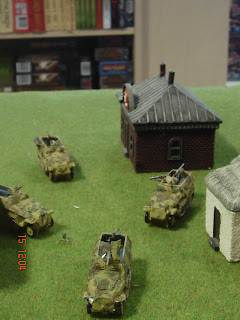Vilnius 12th July 1944
Overview;
As the Russian juggernaut steam rollered through the eastern front the German high command authorised the withdrawal from the Lithuanian capital of Vilnius. The order arrived to late and the garrison was encircled in a pincer movement by the Russian 5th army. Undeterred the German high command then order the 6th panzer division to break through the Russian lines and enable the garrison to escape.
Terrain;
The battle field is set-up as per the map shown.
The woods and marshes are impassable to vehicles and count as difficult terrain for other teams.
Deployment;
The German garrison deploys first in and around Vilnius. All the garrison teams count as being in prepared defences.
The Russian initial force deploys second it can deploy anywhere on the table but cannot be within 18" of a garrison team or within 12" of the German relief enter point. The Russian initial teams count as being in prepared positions.
The German relief force arrive on turn one and enters at point A on the map.
The 3rd guard’s tank corps is in delayed reserves. It enters at point B or C roll for the entire force to determine their entry point
The 3rd guard mechanised corps is in normal reserve but can only arrive after the tank corps has arrived. It enters at point B or C roll for the entire force to determine their entry point.
The Germans get the first turn.
The forces
German Garrison force (counts as a grenadier company)
Company HQ (with attached Panzershreiks)
2 grenadier platoons (HQ with panzerfaust, each platoon has two sections and one attached MG)
1 Grenadier infantry gun platoon (HQ with two gun sections)
1 Grenadier anti-tank gun platoon (HQ with two 7.62mm PaK36(r)
German relief force (counts as a panzer company)
Company HQ (2 PiVs H)
1 panzer platoon (with 3 panthers)
1 panzer platoon (with 4 PiVs H)
1 armoured panzergrenadiers platoon (HQ with panzerfaust and three sections with one attached MG)
1 Panzergrenadiers platoon (HQ with panzerfaust and three sections with one attached MG)
1 Panzergrenadiers pioneer platoon ((HQ with panzerfaust and two sections in trucks)
1 Tank hunter platoon (with 2 Jagdpanzers)
2 truck platoons (each with three trucks)
1 armoured artillery battery (HQ with one gun section of three Wespe and one PIII OP tank)
1 Self propelled infantry gun platoon (HQ with two Grilles)
Russian initial force (counts as an infantry company)
Battalion HQ (with Commissar and attached Anti-tank platoon)
2 Strelkovy platoons (each with commissar and attached MG)
1 Regimental gun company (with observer team and one platoon)
1 Tank company (5 M3 Stuarts)
3rd guard’s tank corps (counts as a tank company)
Battalion HQ (T34/85 with added anti-aircraft platoon)
1 Tank Company (7 T34/85)
1 Tank Company (7 T34/76)
1 light armoured car platoon (5 BA-64's)
1 tank rider company (HQ with Commissar and three platoons)
1 motorised mortar company (HQ with two mortar platoons)
3rd guard mechanised corps (counts as a mechanised company)
Battalion HQ (M4 Sherman)
1 Tank Company (8 M4 Sherman’s)
1 Armoured transporter platoon (HQ with 4 squads)
1 Tank killer company (4 SU-85)
1 Motostrelkovy company (HQ with Commissar and three platoons in trucks)
1 motorised heavy mortar company (HQ with three mortar platoons)
Victory conditions;
The number of escaped garrison teams determines the victory conditions. Garrison teams can escape by leaving the table at point A. If more than two thirds of the garrison escape it counts as a win to the Germans. If less than a third of the garrison escape it counts as a win to the Russians. Any other result is a draw.
The game last until one side concedes, or the game reaches turn 20 or no garrison teams are left in play.





No comments:
Post a Comment